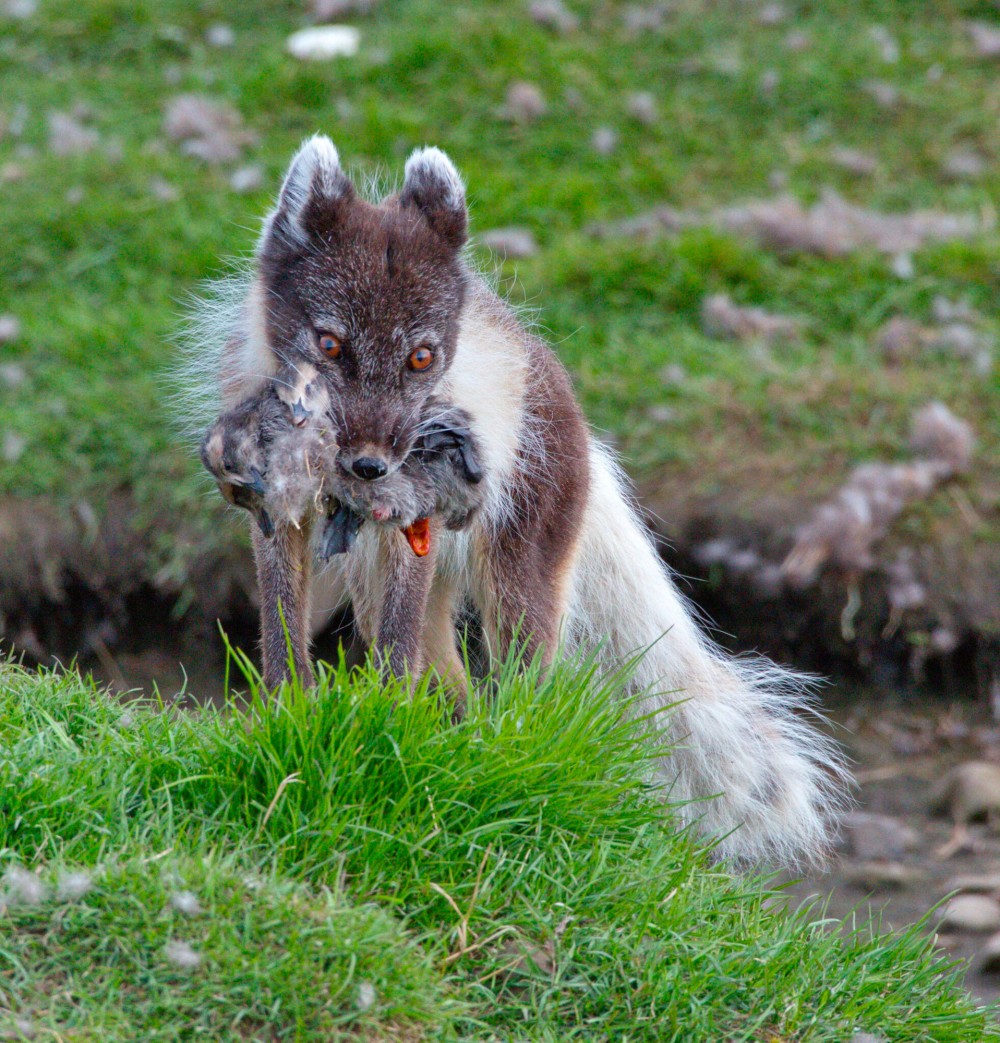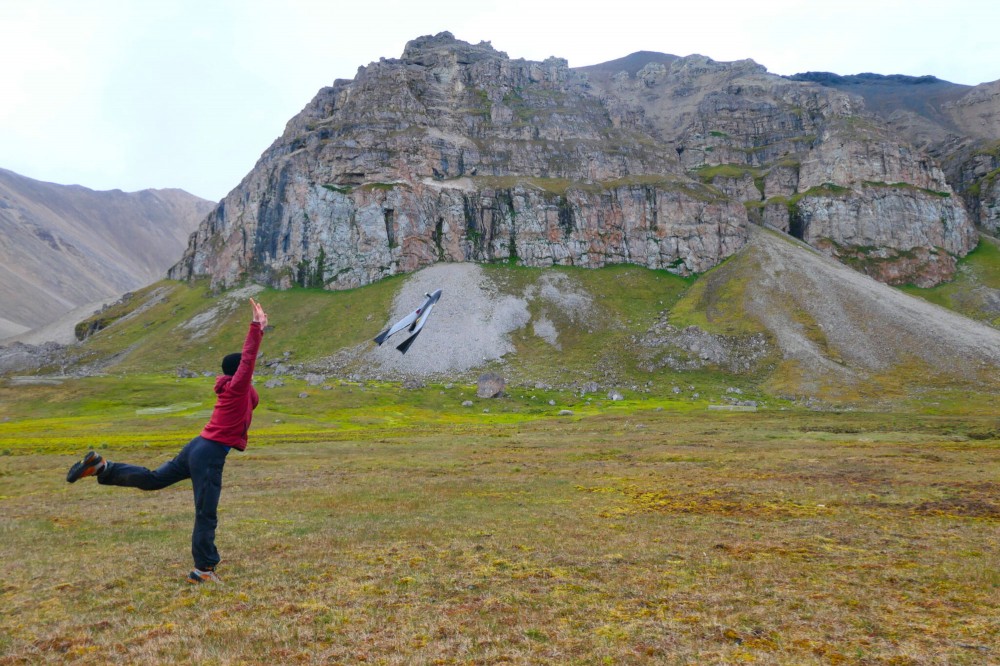
Five decades of terrestrial research in Ny-Ålesund, Svalbard
By: Åshild Ø Pedersen, Jesper Mosbacher, Eva Fuglei, Ingrid Paulsen and Virve Ravolainen // Norwegian Polar Institute
Terrestrial, freshwater, glacial and marine ecosystems are accessible year-round from Ny-Ålesund, providing unique opportunities for interdisciplinary observational and experimental studies in a High Arctic environment. Recently, researchers from the Ny-Ålesund Terrestrial Ecology Flagship programme reviewed and summarised the last fifty years of terrestrial and freshwater research to guide future efforts.
Ny-Ålesund — a hot spot
Compared to other Arctic ecosystems, the Svalbard archipelago has a relatively simple, species-poor food web. However, at Brøggerhalvøya where Ny-Ålesund is situated, the physical proximity and coupling between the terrestrial, marine, glacial, and freshwater ecosystems result in a unique location with considerable environmental heterogeneity and biodiversity for a latitude of 79°N.
With year-round access to state-of-the-art infrastructure and an environment with large physical, chemical, hydrological, climatic, and ecological gradients, the Ny-Ålesund research station and its encompassing ecosystems is a “hot spot” location in the high north for natural sciences. Due to this, Ny-Ålesund, despite being the northernmost research station in the world, has some of the longest time series in the Arctic, with more than five decades of long-term research and monitoring.
ADVERTISEMENT
On Brøggerhalvøya, approximately 20% of the land area is vegetated, hosting a range of High Arctic plant communities typified by bryophytes, lichens, dwarf shrubs, forbs, and graminoids. The peninsula also harbours a high-latitude terrestrial vertebrate community, with only three widespread resident vertebrates, namelythe Svalbard reindeer, the Svalbard rock ptarmigan, and the arctic fox. Voles and lemmings, which characterise many other Arctic food webs, are absent.
During spring and early summer, considerable numbers of migratory birds arrive (ducks, geese, seabirds, snow bunting, and shorebirds), which breed in tundra and freshwater habitats, on shorelines, and on bird cliffs. Polar bears are also occasionally present on land and appear, increasingly, to forage on eider duck and geese eggs in the terrestrial ecosystem.
Rapid environmental changes

Brøggerhalvøya is in the middle of the ongoing climate changes with some of the highest documented temperature increases on Earth over the last decades.
The adjacent Kongsfjorden is undergoing rapid changes, with Atlantification of warmer waters and associated impacts of the marine ecosystem.
Annual air temperature and precipitation, especially rain, have significantly increased the past decades, but with large variation across seasons. Of particular significance are rain-on-snow events, associated with extreme warm spells in winter, which increased markedly in frequency around the turn of the millennium. Winter rain now occurs annually, compared with every three or four years previously, and impacts both plants and animals.
Glacial retreat on the peninsula and in Kongsfjorden has been extensive in recent decades, resulting in the exposure of new ground for weathering and colonisation processes, providing a focus for multi-decadal research into plant and soil microbial community succession. Similarly, the timing of spring snowmelt has advanced, and the active layer of the underlying permafrost is warming and deepening.
Hydrological cycles have also undergone radical changes, with new patterns emerging in the storage and distribution of water resources. Importantly, many of these changes can be partly linked to the marine fjord system, where sea-ice extent and duration have substantially declined. At this outpost on Svalbard’s northwest coast, the effects of increasing temperatures are also evident and visible in the food webs.
Ny-Ålesund – nature’s own laboratory
The review focuses on current knowledge of biodiversity patterns, species population dynamics and interactions, ecosystem processes, biogeochemical cycles, and anthropogenic impacts. A broad cross-section of the terrestrial and freshwater research and monitoring undertaken in the area is under study, and authors highlight and identify key knowledge gaps and future research priorities that this unique location is especially suited to address. Below we give a couple of examples to illustrate.

The reintroduction of Svalbard reindeer and the colonisation by barnacle geese in the late 1970s and early 1980s, respectively, have been the dominant drivers of change in the abundance of terrestrial vertebrates and vegetation communities on Brøggerhalvøya. For instance, in late autumn 1993, an extreme rain-on-snow event on Brøggerhalvøya was a major contributor to the largest known Svalbard reindeer population crash, with the population declining from 360 to 78 individuals.
The inaccessibility of forage due to over-icing, amplified by an overabundance of reindeer, also triggered a substantial dispersal event, most likely across sea ice, and the subsequent establishment of new reindeer populations on coastal plains south of Brøggerhalvøya. The rain-on-snow event increased the number of reindeer carcasses, thus providing more winter food for arctic foxes; this resulted in abrupt increases in fox abundance (monitored since early 1990s). This increase had knock-down effects on the local barnacle goose population. Moreover, climate-driven changes in important life history traits for the barnacle goose may also have cumulative impacts on population trajectories.
For instance, density-dependent mechanisms suppress overwintering survival which, along with predation of goslings by arctic foxes and polar bears, restrict population growth in the area. Later, rain-on-snow events have also led to changes in reindeer diet and behaviour such as increased reliance on marine food resources (e.g. marine kelp and seaweed), and the use of steep mountainous grazing grounds.
These examples illustrate that species-level characteristics and responses are relatively well understood for key vertebrates, but there are still major knowledge gaps for microbes, invertebrates and ecosystem-level processes. Our review highlights the role that research and long-term monitoring have played in unravelling the complexities of ecosystem responses to climate change and other environmental perturbations and, more broadly, contribute to the understanding of the structure and functioning of High Arctic terrestrial ecosystems.

Ecosystem-based monitoring
Many of the most extensive times series from the tundra ecosystem in Svalbard are based on research conducted at or from the Ny-Ålesund research base.

Presently, the NPI driven Climate-ecological Observatory for Arctic Tundra (COAT), at the core of Svalbard Integrated Arctic Earth Observing System (SIOS), is offering a scientifically based platform for integrated monitoring of the terrestrial ecosystem through massive investment in research infrastructure the past 5-6 years.
COAT builds on the long-term monitoring of a variety of institutions, and integrates old and newly established time series, in an adaptive ecosystem-based monitoring of the terrestrial ecosystems.
This scientific platform gives a unique opportunity to build on and integrate other existing and new data series aiming at understanding the complex impacts of seasonal climate changes on High Arctic ecosystems.
Ny-Ålesund today
Ny-Ålesund was originally established as a Norwegian coal mining settlement, operated by Kings Bay Kull Company AS from 1916 to 1962. Mining operations ceased after a major accident in 1962, and regular scientific observations began in 1967.
Today, Ny-Ålesund is one of the northernmost research stations in the world, with world-class research facilities, and year-round access.
The research base has developed into a hub for international polar research, with more than 20 institutions from more than 15 countries currently engaged in research and long-term monitoring programmes.
Due to the history of Ny-Ålesund, most of its buildings are protected as cultural heritage. These buildings constitute the largest collection of protected buildings in Svalbard. The Kings Bay Company still owns the land and most of the buildings in Ny-Ålesund and nowadays provides services for research activity.
The Norwegian Polar Institute is a directorate under the Ministry of Climate and Environment and performs Norway’s host role in Ny-Ålesund. This includes responsibilities for implementation and follow-up of the research strategy. The Polar Institite is the point of contact for scientific research and associated activities, and has the overall on-site responsibility for ensuring coordination. Research at Ny-Ålesund is focused on the natural sciences within the framework of the Svalbard Environmental Protection Act and the Ny-Ålesund Research Station Strategy (The Research Council of Norway 2019).
Long-term monitoring
Researchers from many countries come to the Ny-Ålesund research station to study how environmental changes affect Arctic ecosystems. Frequently, these changes result in multiple stressors on the ecosystem, including climate change, disturbance, non-native species, and pollution. Pollution is increasing in Ny-Ålesund and the rest of the Arctic, and travels via wind and ocean currents from industrialised areas further south.
Several studies on which the researchers base their analyses are part of short and long time series going back several decades; these are also described and summarised in the review article. These time series have great potential when the research community suggests developing current monitoring efforts at Ny-Ålesund into a long-term ecosystem-based monitoring programme, including focal components of the terrestrial ecosystem.
Our review article highlights several current knowledge gaps and makes the following recommendations: 1) build and expand the current long-term monitoring and establish new data series to close key knowledge gaps and become a fully ecosystem-based monitoring programme, 2) gain and improve mechanistic understanding of environmental change impacts on processes and linkages in food webs, 3) identify trophic interactions and cascades across ecosystems, and 4) accumulate long-term data on microbial, invertebrate, and freshwater communities, functional groups for which such data are currently lacking.
These efforts require multi-disciplinary research approaches like those that characterise the four Ny-Ålesund flagship programmes and the adaptive ecosystem-based ecological monitoring approach of COAT (www.coat.no).
The future
While many separate ecosystem components have been studied and monitored in Ny-Ålesund over the past five decades, they have hitherto not been combined in a holistic, integrated, ecosystem-based monitoring effort. Individual research projects have often been short-term and/or taxon-specific, with limited focus on how different trophic levels are interlinked or potentially differentially impacted by climate change.
The review strongly recommends that the international research community at Ny-Ålesund more effectively harmonises its studies to achieve a fully integrated ecosystem monitoring effort, building on currently available datasets, time series and infrastructures, and align with international calls for ecosystem-based monitoring in the Arctic.
COAT research infrastructure
The main authors of this article, who are based at the Fram Centre, have led the recent implementation of the COAT research infrastructure at Brøggerhalvøya. This large-scale effort facilitates and develops the ongoing and newly established long-term monitoring of the terrestrial ecosystem. Here we see Stuphallet, one of the replicated extensive vegetation monitoring sites, where Norwegian Polar Institute researchers Virve Ravolainen and Jesper Mosbacher have established exclosures, camera traps, and plots for studying plant–herbivore interactions.


Eywitness to change
Her first trip to Svalbard was in 1996 as a newly qualified biologist and environmental manager. She was studying Arctic biology on the archipelago, at a time when climate change was really beginning to accelerate and be noticed in the environment. She remembers the winter as having mild and rainy spell. The tundra was covered in ice and there were reports of high mortality rates among reindeer because the ice prevented them from grazing.

In 2012, Åshild Pedersen started working with reindeer for the Norwegian Polar Institute. Since then, the changes in nature have been noticeable – and extreme. In areas around Ny-Ålesund, on the west coast, the reindeer researcher has experienced record amounts of snow, ice-covered tundra, wetter summers with rainfall like what falls in mainland Norway, and extreme glacial melting. Rivers that used to be easy to cross have now become a challenge.
“This extreme weather is a challenge not only for the animals and plants in the ecosystems, but also for us when we try to study them.”
Åshild Pedersen had an unpleasant encounter with the onset of climate change on Svalbard when she first started counting Svalbard reindeer on Brøggerhalvøya and at Sarsøyra and Kaffiøyra in Forlandssundet. The winter of 2012 was also characterised by mild weather, and travelling across the ice-covered tundra was a challenge. The researchers had to resort to snowmobiles with extra studs on their tracks, and use crampons around camp.
Two years later, the Norwegian Polar Institute started its reindeer tagging programme. By this time, it was no longer possible to reach all the localities because the glaciers had changed and could no longer be crossed. In addition, no sea ice formed on the bays, making them equally impassable.
Since then, even more challenges have arisen related to safe travel in the field. Glaciers are retreating or melting, creating new formations and cracks. Rivers can be in full flow in the middle of winter, and spring snow melt starts earlier.
These major changes in nature have affected data collection, forcing researchers to adopt alternative solutions.
“The winter reindeer counts on the peninsulas in Forlandssundet have been cancelled and replaced with counts in late summer. Access by boat is easier – and the data are actually of better quality because they include calf production and the re-observation of tagged animals. Sarsøyra was impossible to get to for some time, and we had our snowmobiles transported there by boat or dangling under helicopters in order to follow up the long-term monitoring programme, which is essential for the understanding of how animals are able to adapt to a changed habitat,” says Åshild Ønvik Pedersen.
This article was originally published in the Fram Forum
The Barents Observer Newsletter
After confirming you're a real person, you can write your email below and we include you to the subscription list.


